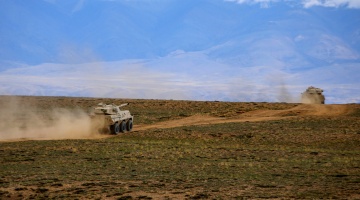By Wang Daning

A US Navy Seawolf-class nuclear submarine docks in Guam.
In early October, USS Seawolf (SSN-21), an attack submarine and the lead ship of its class, arrived at Yokosuka base in Japan. The attack nuclear submarine described by the US Navy as the most expensive, quietest, and rarest attack one has once again arrived in the turbulent East Asia region. What kind of waves will it stir up?
The "Most Advanced" Attack Nuclear Submarine
The design for the Seawolf-class nuclear submarine began in 1983, aiming to counter submarines of the Soviet Union in a deep-ocean environment. The US Navy had planned to build a fleet of 29 submarines over a ten-year period, yet only three were eventually completed due to cost and budget constraints.
According to foreign media, as the "most advanced" attack nuclear submarine of the US Navy, the Seawolfclass has three notable characteristics. The first is a great diving depth. Seawolf-class hulls are constructed from HY-100 steel with higher strength. The publicly disclosed maximum diving depth is 600 meters, far exceeding the typical maximum diving depth of around 300 meters for ordinary submarines. The second is quieter performance. Seawolf-class uses anechoic tiles on the exterior and a shock-absorbing floating raft system inside, making it almost undetectable by sonar even at a cruising speed of 20 knots. The third is high underwater speed. The propulsion system of this class of submarines consists of an S6W pressurized water reactor, producing 220 megawatts of thermal power, which is equivalent to about 300,000 horsepower. Under optimal conditions, it can reach a maximum speed of 35 knots, which even exceeds that of most surface vessels.
The US Navy describes the Seawolf and its two sister ships as "exceptionally quiet, fast, well-armed, and equipped with advanced sensors." Each is equipped with eight 660mm torpedo tubes and can carry up to 50 Mk 48 guided torpedoes, Harpoon anti-ship missiles, or Tomahawk land attack missiles in the torpedo room. After modification, the nuclear submarines can also carry out special operations. They can carry small boats equipped with special forces. After infiltrating into the near seas of the target country, they can deploy these small boats to carry out special operations missions. They can also perform tasks such as underwater eavesdropping and intelligence gathering.
Stir up the regional security situation
United States Fleet Activities Yokosuka, where the USS Seawolf (SSN-21) arrived, is the headquarters of the US Navy Seventh Fleet and the Japan Maritime Self-Defense Force. It is also the only home port for US aircraft carriers in East Asia. The US Navy military once declared that the 7th Fleet would find it difficult to successfully complete any military or political mission without Yokosuka. The visit of the USS Seawolf (SSN-21) sent out multiple signals.
As far as the US military is concerned, it can be seen as its intention to demonstrate forward deployment and exert military deterrence. In recent years, the US Navy has significantly increased the frequency of deploying nuclear submarines to the Western Pacific region to "flex its muscles." The collision accident of the USS Connecticut (SSN-22) in the South China Sea in 2021 indicates that it was carrying out a deterrence mission at the time. US nuclear submarines have also made multiple stops at Naval Base Guam. In August of this year, the US Navy designated Naval Base Guam as the home port for the Virginia-class attack nuclear submarine.
As far as the US-Japan alliance is concerned, this move shows that the US and Japan will promote all-round defense cooperation in maritime strategy. The US and Japan plan to integrate underwater submarines, surface aircraft carriers, and carrier-based air forces to form a more robust system of operational capabilities. This move will have a significant negative impact on the military balance and security outlook in the Asia-Pacific region, and the relevant developments warrant heightened vigilance from neighboring countries.
Unstoppable decline of the US military in the Western Pacific
For over two decades after the end of the Cold War, the US nuclear submarine force, represented by the Seawolf class, enjoyed a period of prominence and was rarely deployed. Today, the Seawolf class has once again been deployed as a primary deterrent in the Western Pacific. It is largely due to the diminished power of US carrier strike groups. Analyses indicate that whether equipped with hypersonic weapons or extending the operational range of carrier-based aircraft, US carrier strike groups find it increasingly difficult to penetrate adversaries' anti-access/area denial (A2/AD) defense zones, leading to a greater reliance on the more stealthy nuclear submarines.
Ironically, USS Seawolf (SSN-21) is the only Seawolf-class nuclear submarine currently available to the US Navy. Boat No. 2, USS Connecticut (SSN-22), was involved in a collision in October 2021 and is still under repair. It is not expected to return to service until early 2026. Boat No. 3, USS Jimmy Carter (SSN-23), adopts advanced technologies that can be used for special operations, tactical surveillance and mine warfare. It has a displacement of 12,158 tons and is approximately 138 meters long. According to Puget Sound Naval Shipyard, USS Jimmy Carter (SSN-23) docked at a dry dock in Bremerton, Washington on August 21 for scheduled maintenance, and USS Connecticut (SSN-22) was also undergoing maintenance there. The limited operational capacity of the Seawolf class also reflects the inadequate capabilities of US Navy personnel and logistical support.













